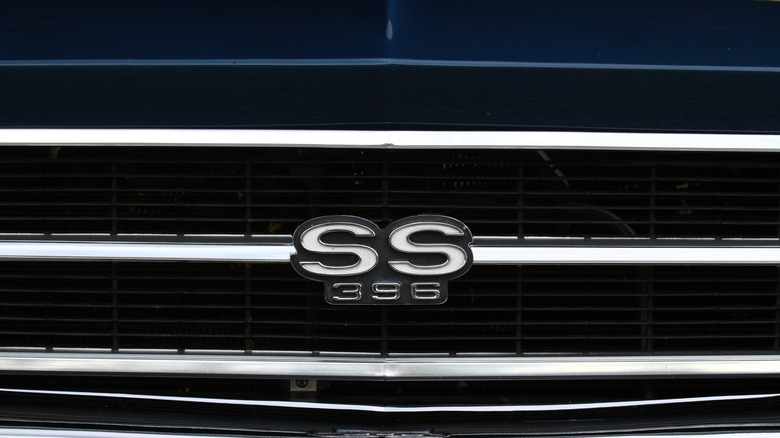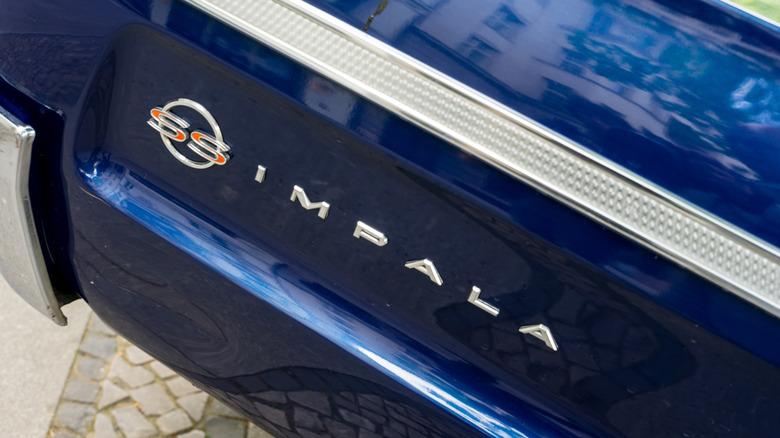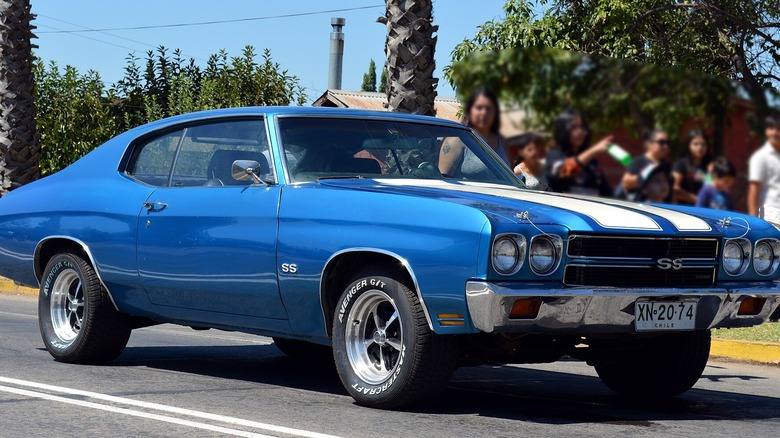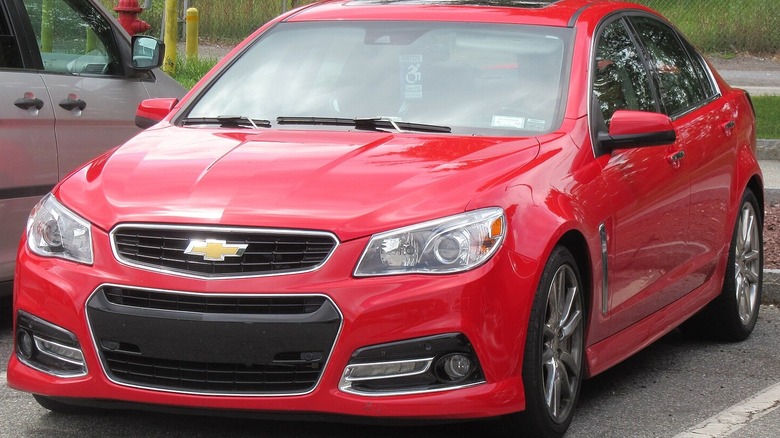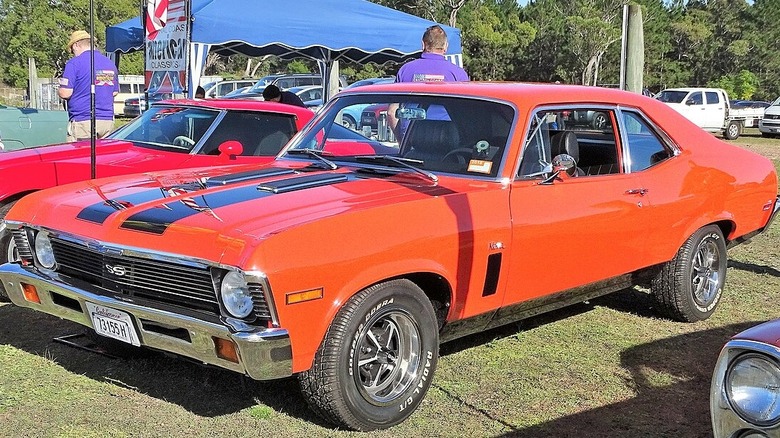5 Of The Most Impressive Muscle Cars Ever Built By Chevy
Chevrolet didn't "invent" the muscle car — that honor usually goes to Pontiac — but it was already building them. Even before the introduction of the Chevelle in 1964, Chevrolet was a go-to source for go-fast cars. Then, after the muscle car era ended and the Malaise era began, Chevrolet still produced vehicles that fit the spirit of the big-engine, intermediate-sized car for going fast in a straight line, and once performance returned in the mid-late '80s (albeit led by Buick's Corvette-smushing GNX) it has done so with regularity.
Some of the most impressive muscle cars from Chevrolet are as famous on the screen as on the track; others sit at stoplights unnoticed until it's time to school the unwary. Also, while the idea of a muscle car has changed over the years, the basic idea of a big engine in a not-so-big car is the same. With that in mind, we'll leave sleeper cars like the big 1990s version of the Impala SS off this list. What remains might contain a few surprises.
1962-1964 Impala SS
While the 1996 Impala SS is one big car at over 4,200 pounds, the early 1960s version weighs in at 3,750 pounds and is barely longer than the 1970 Chevelle SS. You could get an Impala SS in the early 1960s with a six-cylinder, but at the top of the list was the 409 cubic inch grandfather of the 454. Unlike the 327 or 350 small blocks found in these cars, the 409 and 454 were big block engines.
The 425 hp version of the 409 had two Carter four-barrel carburetors sitting on top of it, pushing enough air flow for MotorTrend to run a quarter mile in under 15.0 seconds. The 1964 Impala is a fast enough car, but it's impressive for just how versatile and popular it is. Whether you're into concours restorations, restomod, or low-riders, there's a 1964 Chevrolet Impala SS out there for you.
1970 Chevelle SS 454
Chevrolet's era-defining muscle car is the 1970 Chevelle SS 454 LS6. Even when the car was new, MotorTrend was noting that it was a bit of a swan song, as federal fuel and emissions regulations were coming into play across the country starting in 1972, and rising insurance costs were already plaguing high performance car buyers when the article was fresh. MotorTrend's testers tried to wring every drop out of joy out of the Chevelle while they could.
The 1970 Chevelle SS 454 LS6 wasn't perfect. While the MotorTrend crew liked the Muncie M-22 transmission connected to the 454, changing gears was worrisome as the linkage made shifting something that required attention. All the torque on hand made harder take-offs difficult, too, and the writers noted that switching from street tires to racing slicks might result in lots of drive train parts scattered on the road. Even when the car was new, there was the desire to tinker with it, though the reviewers stuck to upgrading the shocks.
2014 Chevrolet SS
While the muscle car era and its echoes have instantly recognizable classics, there are also cars called sleepers, or Q-ships. They blend into the crowd like a 4-door Malibu with a 396 back in the day, and, in the words of one reviewer, are the "Never let 'em see you coming, just going." type of cars. One such car is the 2014-2017 Chevrolet SS. GM imported them from Holden in Australia with a 6.2-liter LS3 V-8 producing 415 hp and 415 ft-lb of torque.
If there's no replacement for displacement, then the 1970 Chevelle SS 454 LS6 should blow away the newbie. They're about the same size, with the Chevelle at 197.2 inches long and a shipping weight of 3,759 pounds, and the Chevrolet SS at 195.5 inches and a curb weight of 3,906 pounds. MotorTrend launched the Chevelle into a 13.44 second quarter mile in 1970, and the new car at 13.2 seconds in 2015. Tire technology might explain the difference, but the Chevelle had a four-speed manual transmission and the Chevrolet SS had a six-speed manual. No matter how the company did it, the result is Chevrolet's fastest car that isn't a Corvette or a Camaro.
1970 Nova Super Sport
The Chevrolet Nova started out as an inexpensive compact car, as understood in the 1960s, to sell against the Ford Falcon. By the end of the decade, though, the Nova was bulked up and only a foot shorter than a Chevelle. Large displacement engine options came after the 1968 redesign, with the Nova SS introduced in 1969 with a 396 cubic-inch engine in both 350 and 375 hp guises. In 1970 the 402 cubic-inch "396" was available for the Nova SS, but the large block was not destined to stay in the Nova for long, and in 1971, a 350 cubic-inch small block sporting 300 hp was the highest output engine available.
The insurance and emissions issues that spelled the demise of the Chevelle also hit the Nova. Performance wise, by 1973, the SS package was reduced to heavy-duty springs. It was available with any engine, including the straight-six.
2006-2007 Monte Carlo Super Sport
Chevrolet built the Monte Carlo Super Sport in the 1970s, and again in the mid-1980s. 20 years later, the company returned to the idea of a Monte Carlo SS. The first attempt, in 2003 with a normally aspirated 3.8-liter V-6, failed to impress. A supercharged 3.8-liter followed in 2004 with a 0-60 mph time in the mid six-second range, but a 15-second quarter mile. It was a little faster off the line than the 1970 Monte Carlo SS with a 454 cubic-inch engine, but close in quarter-mile terms.
It wasn't until 2006, when Chevrolet put a 5.3-liter LS4 V-8 into the Monte Carlo SS, that things got serious. The 0-60 time dropped to 5.6 seconds and a quarter mile run elapsed in 14.2 seconds, according to Car and Driver. The styling was not loved by everybody, but this was not a sleeper in any sense of the word. Except for handling — Car and Driver wrote about the flabbiness of the suspension, massive body roll. In this regard, the 2006 Monte Carlo was a true muscle car that was built for going fast in a straight line.
